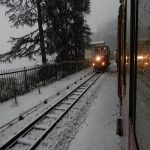The World Heritage-listed Kalka-Shimla Railway Route is buzzing with white snow that shines like silver these days. On his Facebook page, Prime Minister Narendra Modi shared stunning images of a toy train passing through a sheet of snow.
Route is about 96 km long
This 96-kilometer-long route connects Kalka and Shimla (Kalka-Shimla Railway Route). This route has a total of 18 stations. The British had planned this route to transport goods to Shimla, their summer capital. This railway route has now been in operation for 118 years.
103 tunnels come in the way
Kalka station is located 656 metres above sea level. This train then travels via mountainous roads to Shimla, which is 2,076 metres above sea level. This route includes 869 minor and major bridges as well as 919 curves. The train turns at an angle of 48 degrees on several sharp turns. This route also has 103 tunnels, which adds to the excitement of the journey. The longest of these is the Barog tunnel. It is 1143.61 metres long. It takes the toy train two and a half minutes to cross the tunnel.
Read More: Google Pixel Watch reveals its launch date in May 2022
Toy train running on narrow gauge
The railway line between Kalka and Shimla has a narrow gauge. The track width in this case is two feet and six inches. The historic Arch Gallery Bridge built at Kanoh Railway Station is also on this route. This bridge was constructed in 1898. This four-story bridge is made up of 34 arches. The thrill of the toy train passing through this bridge is something else.
UNESCO has given World Heritage status
Because of the historical significance of this train, the Himachal Pradesh government designated it as the state’s pride in 2007. The following year, in 2008, a UNESCO team visited the railway route and designated it as a World Heritage site. Only three routes in India have received this designation. The remaining two routes are operated by toy trains in Darjeeling and Nilgiri Hills.
Baba Bhalku’s contribution in laying the track
Baba Bhalku, a local villager, made significant contributions to the completion of this railway track. He was illiterate, but an English engineer had shown him the way to the tunnel using only a stick and no modern equipment. He was also honoured by the British. In Baba Bhaluk’s honour, a museum was also built.



